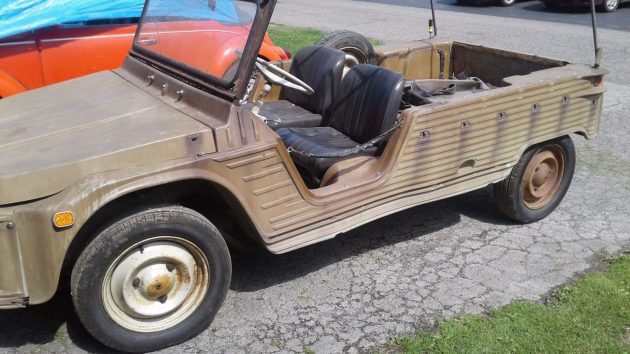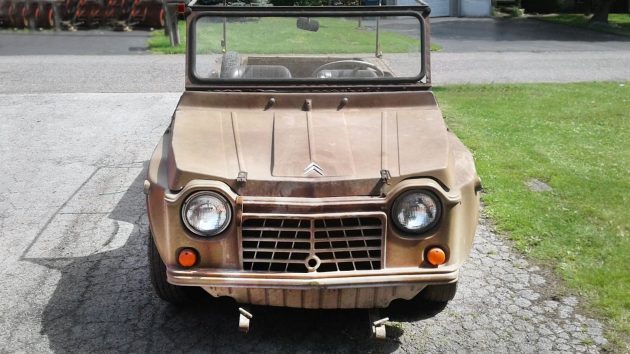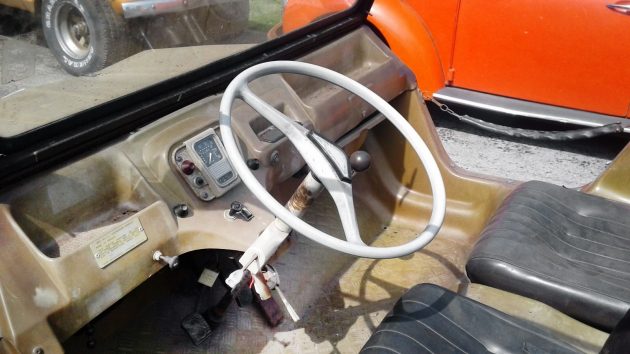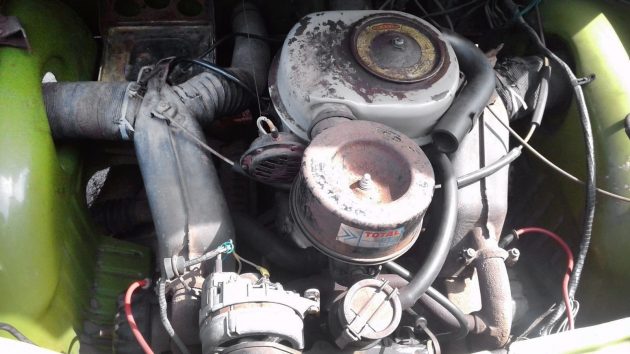How many of you were alive in 1970? I think my dad, who would have been 79 years old on July 15th, would have gotten a kick out of seeing this 1970 Citroën Méhari parked next to his 1956 Pontiac. This rarely-seen half-safari-half-Disneyesque vehicle is in Hubbard, Ohio and can be found on eBay. You won’t be driving this one home, unless you live across the street from the seller.
I don’t know which one I like best, an Austin Mini Moke, a Fiat Jolly (or, a Honda Jolly!), or a Citroën Méhari. The Citroën Méhari is unique in that it has ABS (Acrylonitrile butadiene styrene) plastic body panels, which could, and sometimes should, be changed when they get to be in rough shape. This faded.. tan? I’m not even sure what this color is or why it is this color, I think the original color of this one would have been Vert Tibesti (i.e., lime green) or Vert Montana. Unless a person was planning on taking this to the desert to hide from someone, or something, why on earth would they have changed it from that fantastic green?
The ABS panels are riveted to a metal frame, a very, very non-crashworthy metal frame. Hagerty lists the value of a #4 fair condition Méhari as being $8,300 and a #2 excellent condition one as being worth $21,600. The current bid on this particular vehicle is just over $3,100 now, but the reserve isn’t met. There will be a lot of work to do on and under this one, it’s about as rusty as you would probably ever want a vehicle to be. The windshield frame is holier than Chartres Cathedral and I’m not sure if you even want to know what the frame looks like. Actually, if you’re a bidder on this one, you probably do want to know, and it isn’t pretty. The next owner will want to strip this thing bare and get that frame in perfect condition, order up new panels, etc. If price is no object, of course.
For the US market, the Méhari was classified as a truck due the more relaxed safety requirements for trucks. They were available in the US in 1969 and 1970 and they had a cool hidden rear seat that you could flip over to haul things in the back, or flip it up to carry passengers, without seatbelts because this was a “truck” and they weren’t required. Luckily there isn’t too much horsepower to work with here, but you probably still don’t want to drive too recklessly with one of these.
This is a whopping 602cc, 37 cubic-inch boxer, flat-twin with around 32 hp, and you can see the green color/colour under the hood. This vehicle only weighs 1,200 pounds, but once you load it up with unbuckled friends and start hopping over sand dunes, you’ll probably wish that it had more power. The seller says that this “car has been sitting for a numbers of years. Car will but need tank cleaned and possibly carb rebiult [sic] to run properly.” There were supposedly just over 200 that were sold in the US in 1969 and 1970 so they’re rare. Is this one worth restoring?







A number of years ago, a friend and I saw several of these in, of all places, Jerome, Arizona. Somehow, it seemed appropriate. Jerome is — or at least was — a strange place.
With the exception of the body, these were pretty much assembled from 2CV parts bins, so most replacement bits won’t be impossible to come by. The supplier Scotty cites for body panels lists complete new platforms as well, though these are pricey.
I like Basic Cars, which this is. It bridges the gap between the 2CV and, say, an Irish Mail.
Yes, these are basically 2CV’s with that plastic body. And yes they suffer from the same problems but also the same benefits. But they are sooo much fun. Drive it with your foot to the floor with the engine screaming, and they will shift like nothing else. And with the soft bouncy suspension. And they lean over further than a London bus!
Looks like a glorified golf cart. Pretty straight forward. So what, the French don’t, or didn’t believe in restraints of any kind? Those chains are hardy enough where you might take this thing. Appears, with that rust in the channel, 1st bump it will break in half. It’s French, so it’s odd ( to me). This thing is probably wondering how the heck it got to Ohio?
I remember a tv sitcom from the early 70s called The Brian Keith Show in which he played a pediatrician in Hawaii. This is exactly the vehicle he drove in it.
It appears to have a notch in the upper “Flywheel” where you could use a rope to start it if necessary. That’s pretty cool. In the late 50’s my father had a lawn mower that was started with a unattached rope. It was a two horsepower horizontal shaft motor, belt drive, and, a reel type. By pulling up on a lever, a tension wheel was drawn tight to the belt to engage the cutting reel. Although factory made, it was a scary, dangerous looking beast. Wish I still had that old thing.
I’m afraid this car is more of a novelty than practical transportation.
I used to own a Mehari. You only needed a few tools to work on it and it’s dead nuts reliable. I sold it because I thought it was too slow. Of all the cars I have owned its the one I regret selling the most.
New metal frame or chassis is about 1800 euro s in Holland , or The Netherlands .
I’ve been around these since 1970 when they were new and still own a real decent survivor today. Earlier this month we had a brand new one at the shop with all of 14 miles showing. We recently glued one back together for a guy in San Diego and it turned out GREAT!
The gearing is shorter than a 2CV. They will go right up or down a flight of stairs. With a mild suspension lift (very easy to do) and all terrain tires they are a supreme little off road beast while getting 30 mpg.
Values are on the rise and USA specific models like this one are exceedingly rare now. Perhaps all of 100 worldwide survivors and a smattering of parts cars found here and there.
These are very popular in Europe, especially in French beach towns. Sometimes you see a half dozen a day. Almost all parts are available and reasonable:
https://www.mehariclub.com/catalogues/MEHARI/index.html#p=1, although it can be expensive shipping to the US. The rule of thumb when rebuilding a Mehari, or a 2CV for that matter, is to replace the chassis. They are quite thin and almost always rusty. And, the worst rust you can’t see by looking under the car. They now make galvanized chassis for most models.
This Mehari – and 20someK later, this is what you can get….
https://www.facebook.com/media/set/?set=a.523495431156666.1073741829.496832987156244&type=1&l=33d54fa770
I live and grew up in Whitehall, NY. We had a Citroën dealer in the village and “Catfish” were a common sight in town. A red Méhari ran around town for years. We always laughed at it as it looked like it was made of corrugated roof panels. I believe the dealership mechanic works summers at a local marina on Lake Champlain. He was the last owner that I recall. Good vehicles but definitely strange, especially the SM model.
Well it didn’t sell and the bidding close at 4100 roughly. So I guess this one is either not worth what the owner believes it is or most people don’t believe it’s worth what the owner thinks it is worth. One other interesting thing of note is, that the link provided by somebody for that other one that was restored had the exact same color as this one. Maybe that is how the lime green color Fades to look like overtime?
Yes – mine was exactly the same as this. Mine also came out of Ohio which is a little interesting. I kept the engine and suspension. Used the transmission for the core and picked up a Burton one. Some would disagree – but most of this car is going to rust away and break apart. I would pay $2500 to get the title, vin plate and core swaps. Then order a complete chassis with engine et al from Burton in the Netherlands. Then pickup a body and tubular frame from Club Cassis and have it all shipped over by boat.
Looks like he wants 8k for it…
https://cleveland.craigslist.org/cto/d/citroen-mehari-very-rare-car/6177136414.html